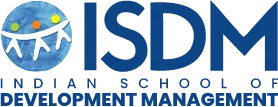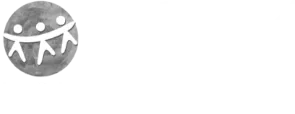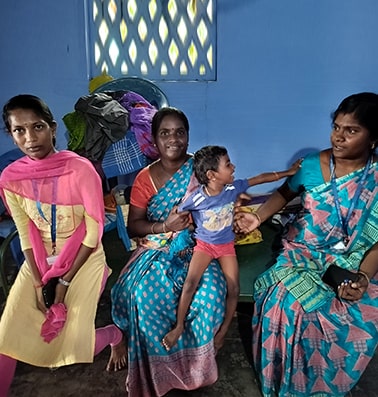
From left: Manimala, a physiotherapist with Amar Seva Sangam, with Veni and Ishalini, along with the Community Rehab Worker, Muthumari.
A long and winding road leads to the Sankarapandiyapuram home of three-year-old Ishalini. Up on a hill near an Ayyappan Temple, with a road that’s motorable but not convenient, and leaves even Google Maps confused, the young child lives with her parents in a hut.
Ishalini speaks, crawls, and is able to pull and grab. That may not sound like much for a three-year-old, but it’s a big improvement for this child, who was diagnosed with cerebral palsy at eight months of age, had seizures and couldn’t achieve head control. And it’s due in large part to the use of the Enabling Inclusion App (EI), an Android application developed by Amar Seva Sangam (ASSA), a non-profit based 4 km away, in Tenkasi district of Tamil Nadu.
In addition to Ishalini’s physiotherapist Manimala, a community rehab worker (CRW) called Muthumari also works with Ishalini. She visits her home weekly and conducts physiotherapy sessions with the toddler, and instructs the parents on how to do it on the days she is not around. Muthumari’s and Manimala’s visits and assessment of Ishalini’s progress are all recorded on the EI app, which was developed in association with a Bengaluru-based software firm.
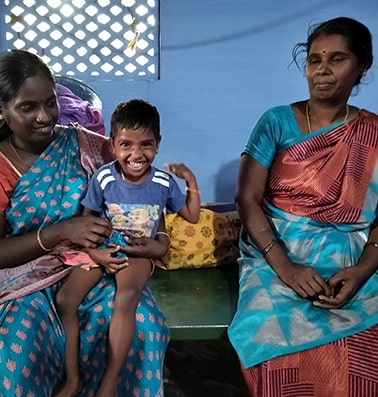
Veni, 26, with her daughter Ishalini (3) and Ishalini’s mother.
Expanding their reach First launched in 2014, EI is now in version 3.8.2. The app has allowed the ASSA team to efficiently handle their community rehab program. ASSA was established in 1981 in a small village Ayikudy in the Tenkasi district of Tamil Nadu as a non-profit by S. Ramakrishnan, who suffered a spine injury during a naval recruitment test.
ASSA was established in 1981 in a small village Ayikudy in the Tenkasi district of Tamil Nadu as a non-profit by S. Ramakrishnan, who suffered a spine injury during a naval recruitment test.
Students playing santulit bhojan gameVeni, 26, with her daughter Ishalini (3) and Ishalini’s mother.
When it started, ASSA would conduct polio awareness camps within the community. In the 1990s, it expanded its operations to institution-based rehab.
“In the early 2000s, ASSA would serve 20 OPD and around 30 in-patients daily,” says Ramasubramanian P, the head of Rehabilitation. But the dream was to scale and to set up a much-needed rehab program for the disabled, especially children with disability.
By then, ASSA had already set up Community Based Rehab (CBR) programs – a clinic-type centre that served 20-30 villages in a radius of 10 km. But there were challenges. Even though all the treatments by ASSA are free, patients’ visits weren’t timely, eventually affecting their treatment plan and outcome, says CA. S. Rajeshwaran, the chief accountant at ASSA.
In 2014, ASSA’s secretary, S Sankara Raman met a mother along with her child, who, like Ishalini, lacked head control. “She required an intensive early intervention program and she also had spasticity along with many other issues. I asked the mother to bring the child to one of our centres. She responded saying that the closest centre was too far off, the bus charges would be too high. She wouldn’t have been able to afford that. The area is not covered by our community program,” Sankara Raman says.
Sankara Raman decided to find a tech solution that would allow anyone, even those in remote areas, to access the rehab – and that was the genesis of the EI App.
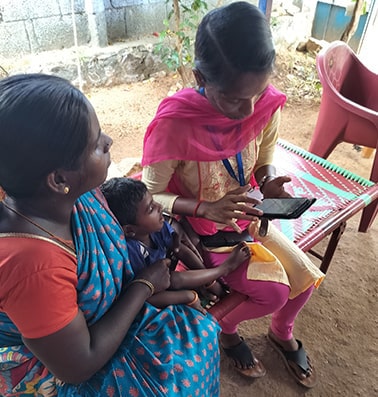
Veni, holding Ishalini, as Manimala, looks at the Enabling Inclusion App to check Ishalini’s progress in the last two years.
Better healthcare through tech
Bikaner School in KawaniVeni, holding Ishalini, as Manimala, looks at the Enabling Inclusion App to check Ishalini’s progress in the last two years.
The EI App helps the team at ASSA monitor care right from the moment users (ASSA prefers the term compared to ‘patient’) join the program.
When a user is screened and their diagnosis is done, a case file is created along with the list of disabilities–the app lists 21, including motor, speech, visual and intellectual disabilities. The system also generates a treatment plan along with a schedule. Once the user/user’s parents, the therapist and the community rehab worker give their okay to the schedule, appointments are fixed – almost like a recurring meeting on your calendar.
But, it doesn’t end there. The daily schedules and GPS locations of the therapists and CRWs are also seen on the app’s in-built map so that it’s possible to monitor every member of the team at any time. In addition, therapists/CRWs have to check-in when they meet a user, and check-out when the therapy is completed. The therapists also add their assessments of the child, scoring them on a scale of 1-5 based on improvement, if any, that they see. The tests, scales and therapies are based on international standards and have also been approved by independent research teams that have observed ASSA’s work.
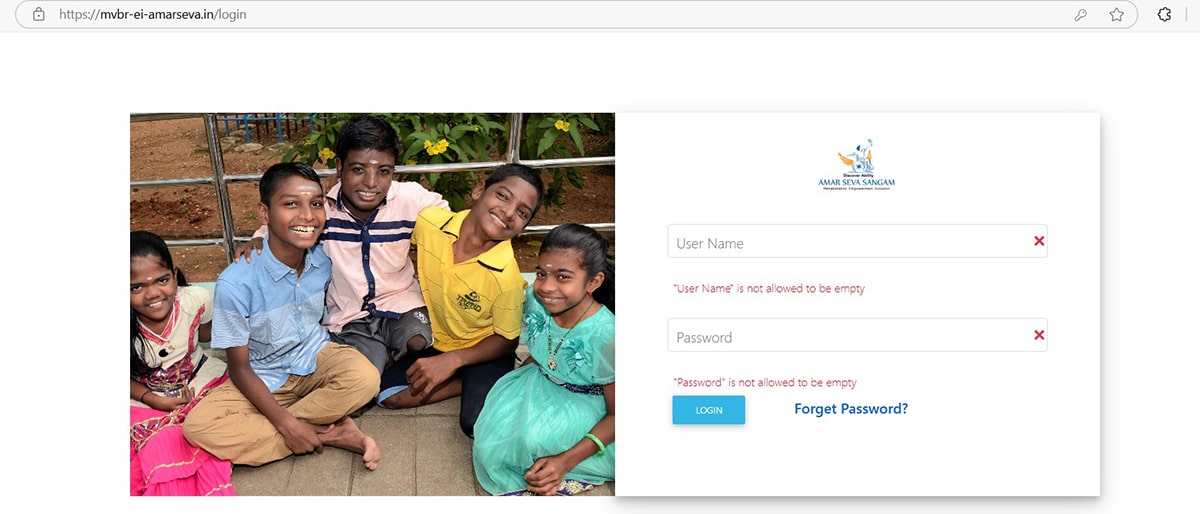
The log-in page of the Enabling Inclusion app. All stakeholders–from physiotherapists to parents of the users–can log into the app to schedule, reschedule appointments as well as to check the user’s progress.
Data-driven insights
Students playing santulit bhojan gameThe log-in page of the Enabling Inclusion app. All stakeholders–from physiotherapists to parents of the users–can log into the app to schedule, reschedule appointments as well as to check the user’s progress.
The app is rich in data. In addition to sharing whether treatment goals have been met, and flagging if a visit has been missed, it can tell you about the child’s progress at a glance.
This kind of data has helped ASSA establish links between regular therapy and larger goals–the social empowerment of the child and improvement in the child-parent relationship. It has given them insights for their work too. For instance, there is a direct correlation between increased visit compliance and the rate of child enrolments in school.
As per a report titled Disability in Tamil Nadu: Levels and Inter-district Variation, published by the Population Research Centre, a study conducted in Tamil Nadu reported that 1.64% of the population were disabled. Also, 59% of the children in the age group 4 years and above and 37% in the age group 4 to 14, were not enrolled in the school.
ASSA estimates that before using the EI app, they were able to reach only a few hundred children. Since its launch in 2021, they have provided services to 3,700 children through the direct implementation program.
And this has had a direct outcome on the wellbeing of children. ASSA found that as visit compliance with its programs increased, the proportion of children enrolled in school also increased. It rose from 70% to 85% within just five years.
These findings have been published in a paper titled “Rapid-Cycle Evaluation in an Early Intervention Program for Children With Developmental Disabilities in South India: Optimizing Service Providers’ Quality of Work-Life, Family Program Engagement, and School Enrollment” in the journal Front Public Health.
Data also showed the ASSA team that the caregiver strain reduced with increased treatment compliance, bolstering the argument for a family-centred early intervention therapy program.
Take the case of Shreemuthu Mohana Lakshmi. When the eight-year-old comes to the ASSA centre in Melapavoor, on a weekday after school, she is accompanied by her father Sarvanann. Sarvanann says over the last years there has been a great improvement in Lakshmi’s abilities. “She was not turning at all, but now she can walk with some help,” he explains. The daily check-ins at the centre and the videos on the app also help him with the physical exercises at home.
Technology for impact
Data insights from the use of EI have helped ASSA scale the program to other areas.
![]()
In 2017, armed with the data from the Enabling Inclusion app, ASSA approached the Tamil Nadu government for funding for scale-up. The government approved a pilot project, which allowed ASSA to scale up the program for three years in three districts. Based on the positive outcomes, the government launched an expanded program statewide based on the Enabling Inclusion model, called RIGHTs. This all came about “because the data we shared clearly showed that child and parent outcomes and program outputs significantly improved,” states Dr Dinesh Krishna, Director of Strategy, Enabling Inclusion. The funding for RIGHTs came in from the World Bank.
ASSA has also set up a Centre of Excellence with the aim of becoming a knowledge leader, and sharing the benefits of the app and their knowledge and experience with data-driven decision-making with other organisations.
ASSA has licensed the app to 23 other non-profits across India, and the team helps them in customising it to their needs. They also help train their therapists, set up a model for their programs and even find funding.
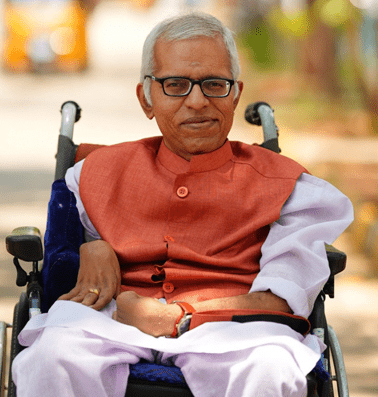
ASSA, says Sankara Raman, also wants to expand the EI App and add more intellectual disabilities to be able to address a larger population. There are certain obstacles such as finding a standard that fits both international guidelines and also Indian cultural norms. “For example, in the West if a child is sleeping with their parents after the age of three, it’s considered a negative output. In India, it’s a negative output if the child isn’t sleeping with the mother at that age,” he explains, adding that defining a standard practice here, is a work in progress.
This project promises a deeper understanding on disabilities across spectrums in India. And a promise of a different future for children like Ishalini.
Without the therapy, Ishalini would have spent the rest of her life lying in bed. Today, she can sit up, stand up, and walk with support. Like any 3-year-old, she is still shy around strangers. But is happy to smile for the camera.
Read this story in graphic novel format: Click here
Want us to tell your data story? Write to us at cdssi@isdm.org.in with “Data Stories” in the subject line.
